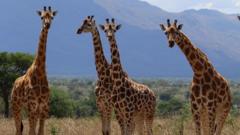Giraffes, often celebrated for their unique stature, are now classified into four distinct species, according to recent findings by the International Union for Conservation of Nature (IUCN). This revelation marks a significant shift in how we understand these majestic creatures.
Historically considered a singular species, new scientific assessments reveal that giraffes possess enough genetic diversity to warrant recognition as four separate species. Researchers conducted an analysis of skull size and head shape across different populations and examined geographic barriers like rivers and mountain ranges that may have facilitated divergent evolution among giraffes.
Among the new species identified, the Southern giraffe resides in southern regions of Africa, including South Africa, Angola, and parts of Namibia. This population is believed to have been isolated by the Kunene and Zambezi rivers, as well as the Congo Basin's dense rainforests.
The second new species, the Reticulated giraffe, inhabits the savannas and woodlands of Kenya, Somalia, and Ethiopia. Its separation from neighboring giraffes likely resulted from geographical features such as the Tana River and various mountainous areas.
Next, the Northern giraffe, which roams regions including south-central Ethiopia and Uganda, has been physically separated from other giraffes by the Nile River and Lake Victoria, in addition to its migratory behavior.
Finally, the Masai giraffe, known for its striking leaf-patterned coat, is distributed across Kenya, Tanzania, and Uganda. Its distinction arises from both geographical barriers—namely Lake Victoria and the Nile River—and the visual differences in its coat pattern, which can vary even among individuals.
The IUCN emphasizes that recognizing the genetic differences among these giraffe populations is crucial for effective conservation efforts. "A precise understanding of giraffe taxonomy allows us to assess their status and foster strategies for their protection," stated Michael Brown, co-author of the report. Previously classified as a vulnerable species facing extinction, the IUCN plans to reassess the status and conservation needs for each newly defined species and their respective populations.
This research heralds a new chapter for giraffe conservation, promising more tailored strategies to ensure the survival of these iconic animals.























